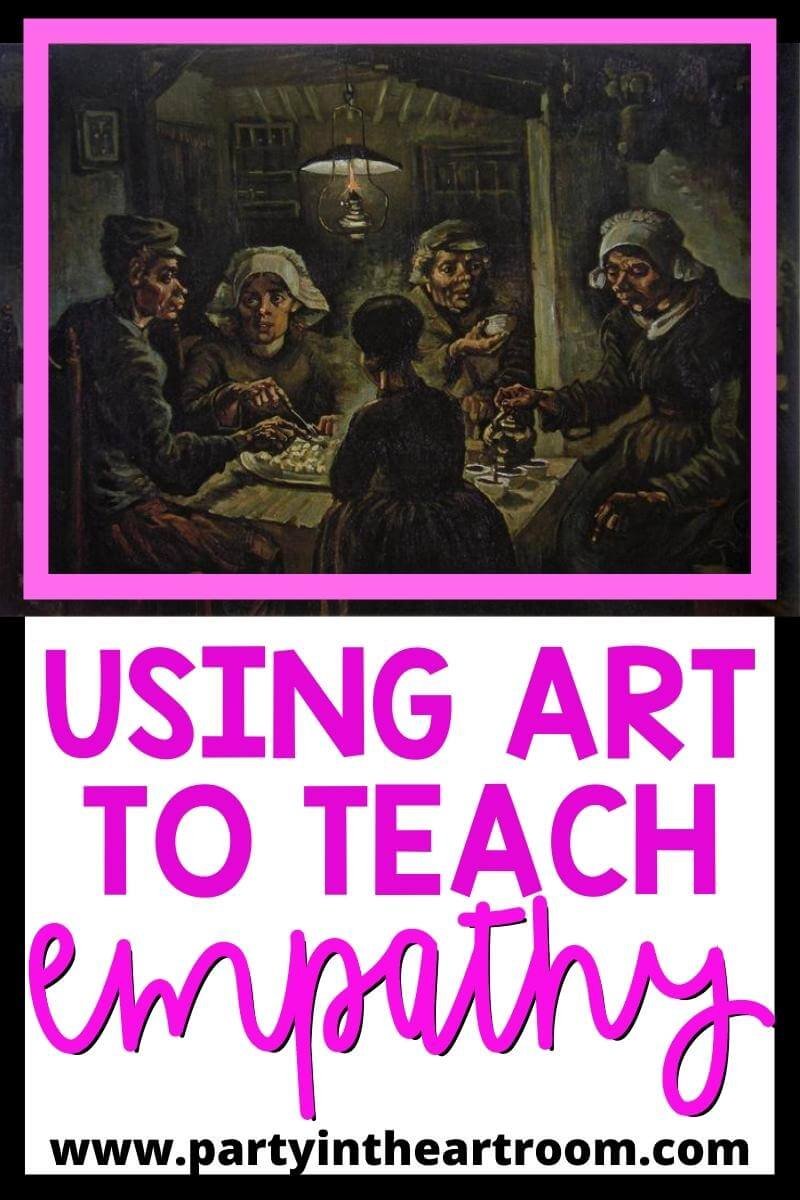Best Ways to Teach Empathy with Vincent Van Gogh
A few years ago I was teaching Vincent Van Gogh for kids to my third grade students. I showed a short slideshow of his major works, one of which was The Potato Eaters. Afterwards, I gave the students a few minutes of time to talk to their neighbors about what they saw, and I overheard this conversation:
“Did you see those people eating? It was that painting with all the people and all the dark, sad colors?”
“Oh, yeah I remember seeing that one.”
“That one broke my heart. They looked hungry and hurt. You could just see that they were hurting.”
I was quite surprised by what I overheard. This was a Vincent Van Gogh for kids lesson after all! I thought the students would choose to discuss the pieces that are more popular in the elementary school setting, such as the sunflowers or the bedrooms. The empathy oozing from that conversation left me with a very specific question: How can I help develop empathy in my students instead of waiting for it to happen haphazardly?
Ron Ritchhart and David Perkins of the Harvard Graduate School of Education’s Project Zero tell us that learning is the direct result of thinking and that the development of thinking is a social endeavor. While this seems obvious, it is worth exploring in the context of the complexity in the nature of empathy as a social skill.
Learning is the Direct Result of Thinking
Simply viewing a work of art can evoke emotions. The colors, the textures, and the subject matter can all impact the immediate emotional response of the viewer. The key to using this surge of emotion to develop empathy is to direct that emotion from being indescribable to something concrete.
After trying several different versions of this lesson, I recommend a variation of Project Zero’s See, Think, Wonder strategy. Students can record their responses on a chart with three columns. The columns would be headed with See, Think, and Feel. Have students explicitly list what they see in the artwork. I think using Vincent Van Gogh for kids is the perfect place to start.
For instance, if students are viewing The Potato Eaters, the See column might include the word plate. Students might list the words only one because they are too poor to buy more next to the word plate as their response for the Think column. Finally, they might add the word helpless in the Feel column. You could give students a word bank of appropriate terms for the Feel column to direct them beyond oversimplification since their go-to words are usually happy, sad, and mad. This strategy of viewing and responding to artwork is akin to the reading behavior of using evidence from text to make inferences. So, there is carryover into the regular education subjects and beyond just the visual art classroom.
The Development of Thinking is a Social Endeavor
The next step is to allow students to engage in conversation with their peers. The See, Think, Feel activity helps to foster a safe environment for students to share their feelings. The evidence from the artwork that was listed in the See column provides students with a concrete, factual element to which they can refer when discussing their feelings. It’s like a security blanket that adds a protective layer to their vulnerability. Simply put, it is just easier to share something so personal when you have evidence to explain why you feel the way you do.
I recommend directing this conversation by asking students to share their See, Think, Feel charts in pairs. When one person is finished sharing, the other should repeat back to them what they heard. This validates their responses, ensures engagement, and helps students develop their speaking and listening skills.
Follow Up
Neuroscience has shown that children who have a solid, well-developed sense of self have a greater capacity for empathy. The See, Think, Feel activity allows students to think about their thinking and emotions. They are able to share with peers in a safe, accepting environment.
Follow up is important for this activity to be effective. A writing activity that allows the students to expand on their See, Think, Feel chart is appropriate. Students can write more about their feelings after having the benefit of peer discussion. Have them carry this writing through the entire writing process to make it even more integrated with language arts.
Empathy is the ability to understand and share the feelings of another. Viewing the art print and connecting their own feelings to what they see allows them to learn about themselves. In turn, when students better understand themselves they can better understand others. As teachers, we can assist our students in the development of empathy as we let them think to learn and partake in social interaction within the safe environment of our classrooms.
If you want to incorporate Vincent Van Gogh for kids in your art room, I have just the place to start. I created a bundle of Vincent Van Gogh Art Resources. It includes informational texts about Vincent Van Gogh, a Flowers project, a digital art game, and much more. My students have really enjoyed learning about Van Gogh, and again, I love using his work to connect with empathy as well.
Let Me Know What You Think
What do you think about teaching empathy through art? Do you have any go-to works that are good to use? Let me know! Send me a message on Instagram so we can chat about it.
(Note: This article was first published on the ASCD InService blog.)

